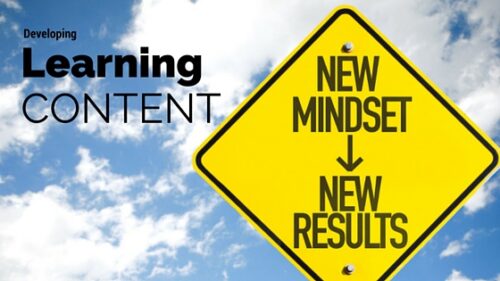Thinking Differently about Learning Content Development and Maintenance
If you spend anytime on the web, specifically looking at product or service sites, you probably have noticed some interesting capabilities. For instance, you can specify a search term, and then get options to customize the view based upon a number of criteria such as size, price, brand, and more. Even more interesting from a ‘user experience’ standpoint are recommendations, where your previous behavior leads to some specific suggestions for you. This is the future of content; customized, personalized, even adaptive.
This customizability and adaptivity is not what we see in the eLearning space. There are a few examples, companies like Knewton and such, but by and large our courses are monolithic objects of code. They aren’t accessible in small bits, they can’t be reassembled in different ways, and they are hard to manage. We can do better.
The New Reusable Learning Content
Let’s get a little clearer about what we’re talking about, specifically for learning. There’s been much talk about the value (or not) of reusing or repurposing content. Here, the point is to make content flexible so that it can be combined in different ways to meet different needs. And the benefits here are to reduce redundancy and increase opportunity.
So, in a typical scenario, content comes from marketing about a new product or service. It may go through engineering or operations to add detail. But what happens then is that the same information goes to sales training for development, but it also goes to customer support, and to technical communications, and maybe even customer training. There’s training and documentation being created all from the same source material, but likely with redundancies.
Another situation is that content is created to create a particular need. So, in the course of developing training, a job aid is created to help comprehension and serves as a guide for practice. This particular content would be valuable to be accessed by the learners after the class, when they’re performing, but it’s not systematically thought through nor automatically made findable. This could be internally, or as a more comprehensive customer solution from elearning providers, but the point is that it is a missed opportunity.
And yet another situation is the familiar legacy content. When I ask at events whether anyone has content hanging around that’s out of date or no longer accurate, but it’s still available, I always see hands. There’s no process for managing content in a particular way. Yet without a systematic process of content review, people can get confused about what’s up to date, relevant, and more.
In web marketing, these problems are being increasingly handled in a mechanism called content systems, composed of content strategy, engineering, and management. They’re working towards intelligent content, content that meets what Wayne Hodgins once termed the ‘right stuff’: the right content to the right person at the right time and the right place in the right way on the right device. Think of this for learning: would you love to have a learning experience that was uniquely configured for you? That’s the possibility. So what’s involved?
A Custom Learning Experience Built Just for You
One of the first steps is getting more rigorous around content. We need content definitions and descriptions that allow us to know what we have and how to access it. Then we need to have systems that support hosting and delivering this content in rich ways. Finally, we need to have a strategy about developing, delivering, and managing the content.
To start, we need a tight level of granularity. I’ve previously suggested that the right level of granularity can be approximated as ‘the smallest thing you’d give one learner versus another, depending on their performance’. A more systematic approach is to talk about content from the perspective of its learning (or performance) ‘role’. That is, to be clear about whether it’s an example, practice, concept presentation, job aid, or more. And yes, that means we must be more discrete in our content development.
We must also be very specific about describing this content, since we will want to pull it together by description, not hardwired together. To do this will require rigor in tagging. We need to describe learning role, topic, context, media, and more. This is the role of a content model, to determine what types of content are needed to fulfill the learning and performance roles we expect. What is the full suite of content needed? This will differ by organization, with a publisher having different needs than a B2B company, etc. With good structure and good descriptions, we facilitate search as well as more flexible content, able to populate different business models and use cases.
Adaptive Content Using Rules
The ultimate goal is to be able to personalize content and make it adaptive. We want to be able to call up content by labels, so we could grab an <example> about <product X> in <context Y> with <video> by rule, and then combine rules to sequence content into courses for different roles on the same content, and vice versa, rather than have to develop them separately. Going forward, we will be able to have rules that provide simpler problems if the learner is doing poorly, and advance them more rapidly, to take advantage of context, and more.
At the same time, we can also be more specific about what constitutes a ‘good’ example, practice, etc. We currently are too lax about the details about what constitutes a really good learning component. So, for instance, a good example wouldn’t be missing elements like cognitive annotation, etc. Here’s an opportunity to address those gaps, making content templates about learning, rather than just window-dressing.
We also need to have systems that can host content, descriptors, and rules, and combine and deliver the content as dictated. While the LMS can still serve the courses and manage competencies & users, the content itself may well be launched from a content management system, perhaps leveraging the content system likely already in use by marketing! There are fundamental capabilities and increasingly we need to think about integrating technology in systemic ways to combine capabilities for new needs.
Learning Content Lifecycle Management
Finally, we need people and processes. We need to make sure that the content lifecycle is covered, from initial strategy to deletion. Who has responsibility for what’s said, for how it’s said, and when it needs to be updated? We need to determine what services content delivers, and how we’re going to get there. We need people to determine the tagging scheme, content model, and ultimately write the rules. And, of course, we also need people who have the job of creating the content!
This is an initial step in going beyond the silos. Properly done, this includes content coming from related business units like technical communications and customer services. While initially it can focus on learning and performance support, eventually all content should be systematically addressed.
And let’s be clear, this isn’t going to happen overnight. We are still in the infancy of custom content development. The point is to start planning and working now on getting to the point where you are using content in more systematic ways. The short-term benefits are in having a more structured approach to content, such as a finer granularity and a deeper definition around the learning content component. The longer-term benefits are in laying the foundations for delivering a more complete learning and performance solution, internally empowering more successful outcomes and externally creating a more complete customer experience. It’s time to be intelligent about content, so we can start getting the advantages of intelligent content.





